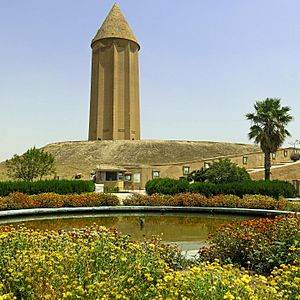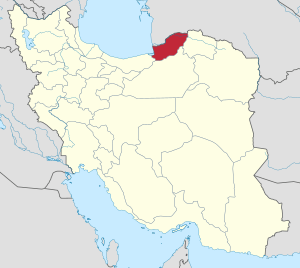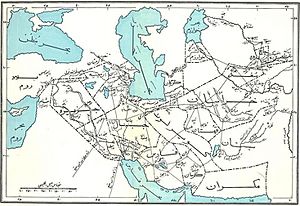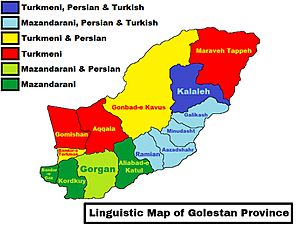Golestan province facts for kids
Quick facts for kids
Golestan province
استان گلستان
|
|
|---|---|

|
|

Location of Golestan province in Iran
|
|
| Country | Iran |
| Region | Region 1 |
| Capital | Gorgan |
| Counties | 14 |
| Area | |
| • Total | 20,367 km2 (7,864 sq mi) |
| Population
(2016)
|
|
| • Total | 1,868,819 |
| • Density | 91.7572/km2 (237.650/sq mi) |
| Time zone | UTC+03:30 (IRST) |
| Area code(s) | 017 |
| Main language(s) | Persian Mazandarani Turkmen |
| HDI (2017) | 0.778 high · 20th |
| Website | http://golestanp.ir/ |
Golestan province is one of the 31 provinces of Iran. It is located in the northeast of the country. You can find it southeast of the Caspian Sea. Its capital city is Gorgan. This city was called Esterabad until 1937. Golestan became its own province in 1997. Before that, it was part of Mazandaran province.
In 2014, Golestan became part of Region 1 in Iran. This was done to help with coordination and development. Most people living here are Sunni Muslims. In 2016, about 1.8 million people lived in Golestan province.
Contents
What's in a Name?
The name Golestan means "land of flowers". It comes from the word "gul-" which means "flower" and "-stan" which means "land" or "region". You'll find similar names in other countries with Persian language roots.
The capital city, Gorgan, also has an interesting name. It comes from an older word meaning "land of wolves". This is why the ancient Greeks called the area Hyrcania. Even today, wild wolves can still be found in Golestan.
A Look Back in Time
People have lived in this area for a very long time. We know this because settlements date back to 10,000 BC! You can still see parts of the ancient city of Jorjan near the modern city of Gonbad-e Kavus. Jorjan was a very important city. It was located right on the famous Silk Road, a trade route connecting East and West.
During the time of the Achaemenid Iran, this area was likely a smaller part of a larger province called Parthia. The people from this region, called Hyrcanians, were even mentioned by the ancient Greek historian Herodotus. He wrote about them joining the army of King Xerxes during his invasion of Greece.
Cities and Divisions
Golestan province is divided into 14 smaller areas called counties. These counties help manage different parts of the province.
Many people in Golestan live in cities. In 2016, over half of the province's population lived in its cities. The largest city and capital is Gorgan, with over 350,000 people. Other important cities include Gonbad-e Kavus, Aliabad-e Katul, and Bandar Torkaman.
Who Lives in Golestan?
Golestan province is home to many different groups of people. This makes it a very diverse place! Here are some of the main groups:
- Turkmens: They make up about 34% of the population. Many Turkmens live in the northern plains, an area called Turkmen Sahra. Their main cities are Gonbad-e Kavus and Bandar Torkaman. Turkmens are mostly Sunni Muslims.
- Mazandaranis: About 30% of the people are Mazandaranis. They are considered the original inhabitants of the area. Many live in cities like Gorgan, Ali Abad, and Kordkuy. They speak the Mazanderani language.
- Sistanis and Persians: These groups make up about 15% of the population. Many Sistanis have moved to Golestan more recently due to droughts in their home areas.
- Baluchis: Around 11% of the people are Baluchis. Like the Sistanis, many have moved here in the last century.
- Qizilbash: About 7% of the population are Qizilbash. They have lived here for centuries and are Shia Muslims.
- Others: A smaller group of people (about 2%) includes Azeris, Kazakhs, Kurds, Georgians, and Armenians. These groups have kept their unique traditions.
Culture and Landmarks
One of the most famous landmarks in Golestan is the Gonbad-e Qabus tower. It is known as the world's tallest brick structure of its kind. This amazing tower is a symbol of the province's rich history.
Nature and Climate
Golestan province usually has mild weather and a pleasant climate throughout the year. The land is divided into two main parts: the flat plains and the mountains of the Alborz range. In the eastern part of the Alborz mountains, the peaks gradually get lower. The highest point in the province is Shavar, which is 3,945 meters tall. Two important rivers that flow through Golestan are the Gharasu and the Gorganrud.
Golestan National Park
Golestan National Park is Iran's largest national park. It stretches across three provinces: Golestan, Mazandaran, and North Khorasan. This park is special because it has many different climates, from humid areas near the Caspian Sea to drier, desert-like areas further south.
However, the park faces a challenge. There are plans to build a road right through the forest. While this might help villagers and woodcutters, it could harm the animals and plants that live there. Experts have suggested building roads around the park instead, to protect this important natural area.
Learning and Education
Golestan province has several universities and colleges where students can continue their education:
- Golestan University
- Golestan University of Medical Sciences
- Gonbad Kavous University
- Gorgan University of Agricultural Sciences and Natural Resources
- Islamic Azad University of Azadshahr
- Islamic Azad University of Gorgan
- Islamic Azad University of Ali Abad katool
See also
 In Spanish: Provincia de Golestán para niños
In Spanish: Provincia de Golestán para niños



